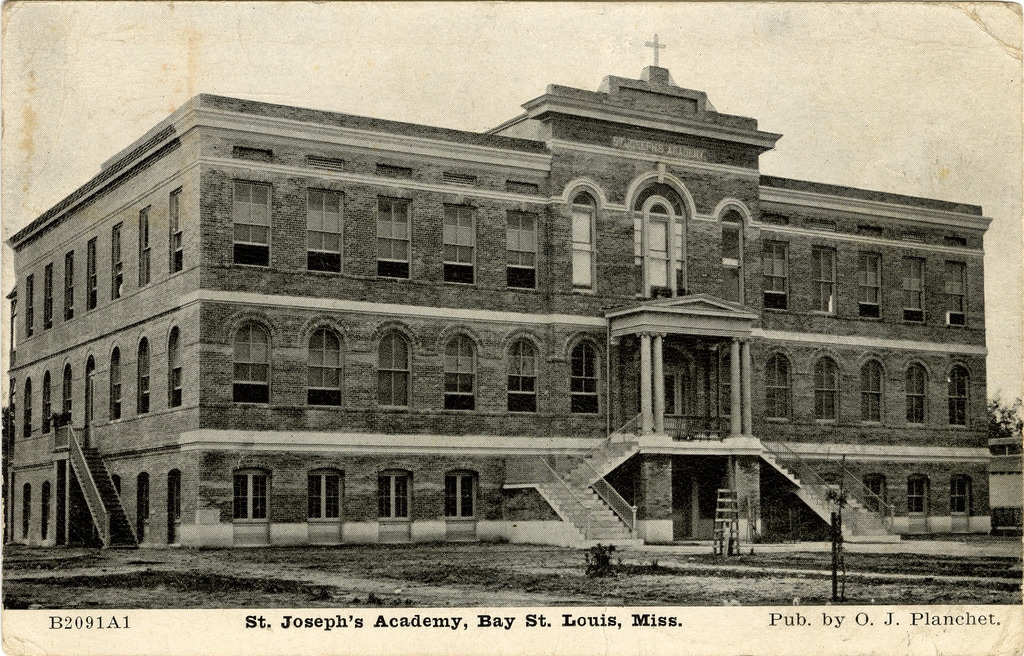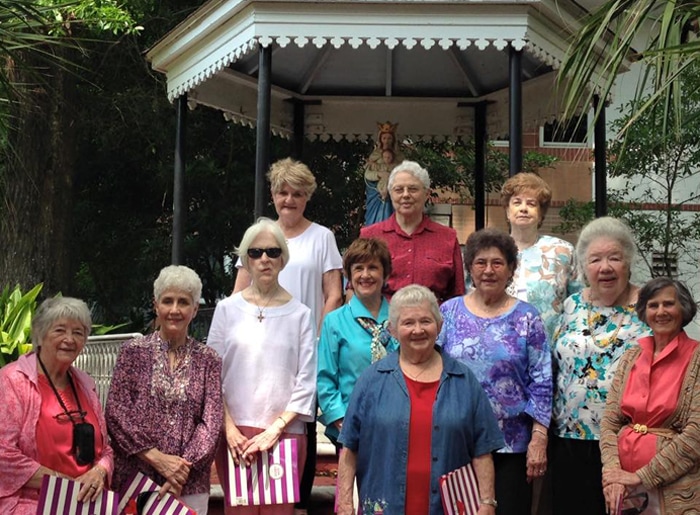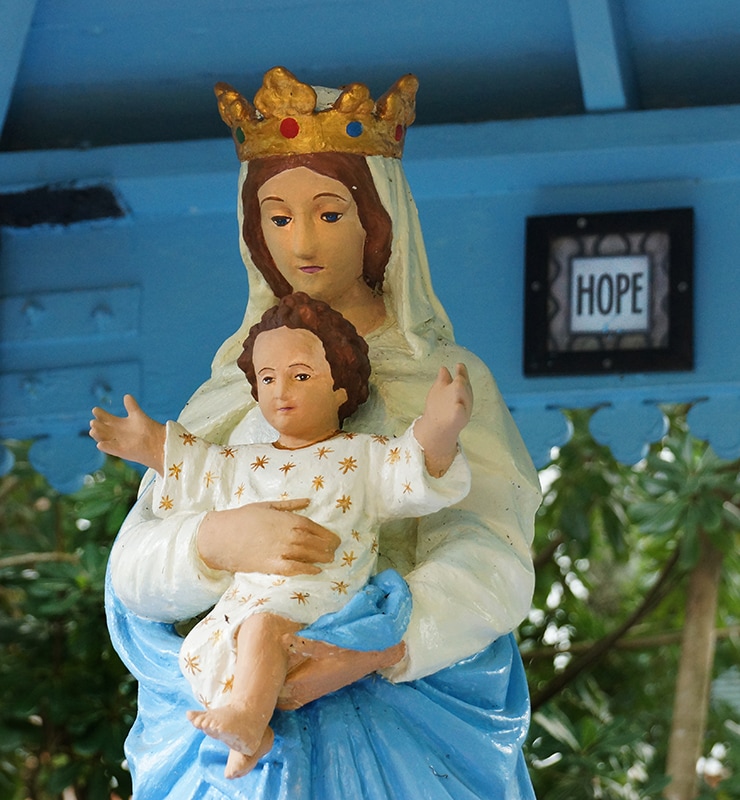Common Ground
A small shrine to Our Lady of the Woods has become a touchstone for two girls' schools - together spanning more than a century and a half.
- story by Ellis Anderson
The grotto was built in the 1860s on the grounds of St. Joseph’s Academy, a parochial girls’ school that was just a few years old at the time. St. Joseph’s was started by three hardy French nuns who made the journey across the Atlantic for just that purpose. Classes filled immediately.
According to an excellent article on the Hancock County Historical Society’s website, the presence of the nuns heartened Father Buteux, the pastor of Our Lady of the Gulf Catholic Church. He wrote about their arrival with great enthusiasm in his 1855 diary. Bay St. Louis then was a primitive village. Living conditions would have been Spartan, even by standards of the day, without conveniences like electricity or running water. Yellow fever and other diseases were always a threat. Yet three more nuns arrived the following year. By the 1860s, when the shrine was built, the school began to offer boarding facilities. Board, tuition and washing (of clothes, presumably, not students), cost parents $220 annually in 1867. The grotto was built after a perilous trip Father Buteux made, sailing from France back to the States. Caught in a violent storm that sheered the mast from the schooner, the priest promised to build a memorial to the Blessed Mother if she would spare the ship and its passengers. In those early days of the city, the shrine was set deep in the surrounding woods. St. Joseph’s Academy continued to grow through the years, gaining a national reputation for scholastic excellence. Unfortunately, an enormous fire ravaged much of the town and destroyed the school and the church in 1907.
The plucky nuns rallied with wholesale community support and found funding to build a new school. They and their students moved into an elegant new three-story building in 1908. In 1924 a companion two-story brick building was constructed. Referred to as the gymnasium, it was used for music and other classes as well.
The ultimate demise of St. Joseph’s came from a scarcity of teaching nuns rather than a diminishing student body. The front building that had been built in 1907 was torn down after the school was closed in 1967. According to one graduate, it was an act that came as a shock to the town’s residents and the alumni who cherished the architectural treasure. The gymnasium was destroyed by another fire a few years later. Hurricane Camille in 1969 scoured the grounds. The Our Lady of the Woods shrine was all that remained. A campus that had been one of the prides of the coast no longer existed. And local parents who wanted a parochial education for their daughters had to look elsewhere.
Then, in the aftermath of Camille, a local attorney with four daughters kick-started a drive to establish a new girls’ school at the site of the former. The late Michael D. Haas teamed with the pastor of OLG, the late Msgr. Gregory J. Johnson and Brother Lee Barker, who was principal of St. Stanislaus College prep school at the time.
Haas’s wife, Myrt, calls herself the original naysayer of the project. When the idea was first discussed, she found it difficult to believe such a grand dream could be brought to fruition. But her enthusiasm quickly caught fire. She remembers that the concept had instant “wholesale community support.” Many obstacles had to be surmounted. For instance, the group discovered the new school couldn’t receive accreditation without a science lab, a library, or language courses – things that seemed out of reach with their limited funds. But Father Lee offered to share the facilities at St. Stanislaus, an unprecedented move. Co-educational programming between the all-boys school and the female students at St. Joseph’s had never before been considered. “Our girls learned a lot from the experience,” says Myrt, laughing. “For one, they learned to put on lipstick before they went over to the St. Stanislaus campus.” Myrt says that the main reason the school succeeded was the good attitude of the early students. In those early days, they didn’t have the resources that the public schools did. For example, there was no cafeteria, considered a school basic. “I give the students credit for sticking with it and making it work,” Myrt says. “Those girls made it happen as much as the parents and teachers.”
Current OLA principal Darnell Cuevas, who’s been at the school’s helm for two years, says that the school’s enrollment is nearly up to pre-Katrina levels now, with more than 250 students. The students are excelling academically as well. In 2017, 38 graduates scored in the top tier on standardized college entrance tests and were awarded nearly $5 million in scholarships.
The Our Lady of the Woods grotto has become a historical and spiritual tie between the two academies. It’s a favorite place for group photographs of students, teachers and St. Joseph’s graduates, who reunite often. In May of this year, more than 40 students and teachers from the final class of 1967 gathered for their 50th reunion. The grotto was a favorite meditative spot for Cuevas, even before she began as principal, and she’s eager to see that her younger charges learn the history of the shrine. Both Myrt and Cuevas speak fondly of the legendary caretaker of the shrine, Sister Albertine, who kept the grotto tidy and with a candle burning at its base around the clock, throughout the year, for decades. Myrt tells the tale of wartime sacrifice that kept Sister Albertine from performing her duties. “During World War II, enemy submarines were patrolling the waters of the gulf,” says Myrt. “We had blackouts every night. Lights had to be turned off in houses and buildings. Even cars couldn’t drive the coast roads with headlights.” “The Coast Guard came to St. Joseph’s, saying that they could see the candle at the foot of the shrine more three miles out in the gulf. Sister Albertine had to stop lighting the candle. But just for the time being.” Comments are closed.
|
Categories
All
Archives
July 2024
|
Shoofly Magazine Partners
Our Shoofly Partners are local businesses and organizations who share our mission to enrich community life in Bay St. Louis, Waveland, Diamondhead and Pass Christian. These are limited in number to maximize visibility. Email us now to become a Shoofly Partner!







































 RSS Feed
RSS Feed























